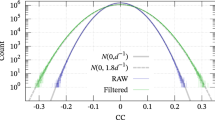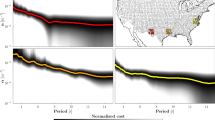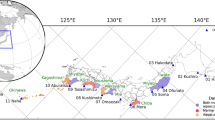Abstract
As recommended at the thirteenth General Assembly of the International Scientific Radio Union1 in London, observations of dispersion (D) of whistlers at calm and disturbed periods are very useful for the examination of geophysical phenomena and for their application to space communications, though very little has so far been done. Since the beginning of the International Geophysical Year (July 1957), we have observed D for 4 years at Toyokawa (geomag. co-ords.+24.5°, 203.5°) and at Wakkanai (geomag. co-ords.+35.3°, 206.0°) and obtained the following results.
This is a preview of subscription content, access via your institution
Access options
Subscribe to this journal
Receive 51 print issues and online access
$199.00 per year
only $3.90 per issue
Buy this article
- Purchase on Springer Link
- Instant access to full article PDF
Prices may be subject to local taxes which are calculated during checkout
Similar content being viewed by others
References
Thirteenth General Assembly, U. R. S. L., IV, Besolution 4 (1960).
Helliwell, R. A., Proc. Inst. Rod. Eng., 47, 200 (1959).
Outsu, J., and Iwai, A., Inter. conf. Cos. Rays Storm, Kyoto, Preprint (1961).
Alleock, G., and Morgan, M. G., J. Geophys. Res., 63, 573 (1958).
Kimpara, A., Rep. Iono. Space Res. Japan, 14, 160 (1960).
Kimpara, A., Proc. Res. Inst. Atmospherics, Nagoya Univ., 7, 40 (1960).
Author information
Authors and Affiliations
Rights and permissions
About this article
Cite this article
KIMPARA, A. Dispersion of Whistlers. Nature 193, 667–668 (1962). https://doi.org/10.1038/193667a0
Issue Date:
DOI: https://doi.org/10.1038/193667a0
Comments
By submitting a comment you agree to abide by our Terms and Community Guidelines. If you find something abusive or that does not comply with our terms or guidelines please flag it as inappropriate.



